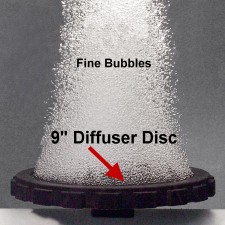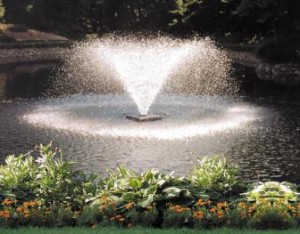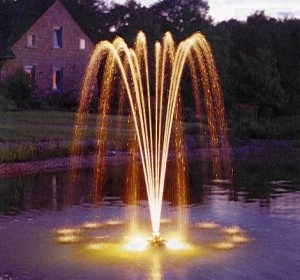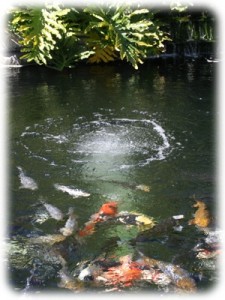Aeration Can Make All the Difference
One item that is often overlooked when setting up a pond or water garden is a good quality aerator. Air pumps are often used in aquariums to move water around and to increase oxygen levels, but many pond owners don’t realize the benefits of using one in a fish pond, or even a pond without fish. Keeping oxygen levels up in any kind of water feature can prevent stagnation by keeping beneficial bacteria thriving and thereby keeping the pond healthier, looking much cleaner, and smelling nicer.
In a fish pond or decorative water feature we normally rely on water pumps to circulate and aerate the water, but while the flow rate of the water pump may be sufficient for the aesthetic of the waterfall or fountain portion of the water feature, it still may not be sufficient to properly aerate the entire pond. There may also be areas in a pool of water where water does not adequately flow due to the shape of the pool or some type of obstruction so that just certain portions of the pool gather debris and stagnates. Ponds over three feet in depth can be especially oxygen deprived at the bottom. Poor aeration can often lead to excessive algae growth (green water), sludge buildup, and can stress or even kill fish, especially when the water is very warm. The worst times for oxygen depletion are early mornings in the summer (after plants have been respirating all night) and just before a thunderstorm.
Adding an aerator in the form of an air pump with air hose and an air diffuser, or a fountain that adds splash and water movement to the pond can alleviate the problems that come from stale, stagnant w ater. An air pump sits outside the pond with a hose leading down into the pond with a diffuser attached at the end. The diffuser breaks up the air that is going through the tubing into tiny bubbles so that as much of the gas is transferred into the water as possible. Your standard aquarium pump is usually not powerful enough to push air down through the depths that most ponds have, and most are not designed to be placed outdoors. Even pond air pumps can withstand the weather for only a short while, and most people will cover and disguise their air pump with a special housing, flower pot, or artificial rock. Any cover that you place over the air pump must have adequate ventilation to keep the pump from overheating and to allow clean air into the pump that can then be forced out and into your pond. The size and depth of the pond determines how powerful the air pump needs to be, but their are aerators for even the largest ponds and reservoirs.
ater. An air pump sits outside the pond with a hose leading down into the pond with a diffuser attached at the end. The diffuser breaks up the air that is going through the tubing into tiny bubbles so that as much of the gas is transferred into the water as possible. Your standard aquarium pump is usually not powerful enough to push air down through the depths that most ponds have, and most are not designed to be placed outdoors. Even pond air pumps can withstand the weather for only a short while, and most people will cover and disguise their air pump with a special housing, flower pot, or artificial rock. Any cover that you place over the air pump must have adequate ventilation to keep the pump from overheating and to allow clean air into the pump that can then be forced out and into your pond. The size and depth of the pond determines how powerful the air pump needs to be, but their are aerators for even the largest ponds and reservoirs.
Another option to increase aeration, besides the air pump and diffuser combo, is a fountain that creates splash on the surface of the pond. These can be very beautiful, especially in large water features where water shooting into the air is very dramatic. A fountain lit up at night is often quite spectacular. There are versions for small pools that pull water from the bottom, but most of these that you see will use a floating base with either a pump or motor just below the surface to force the water into the air. The drawbacks to this type of aeration are that most of the water is pulled from the surface, so there is not much circulation going on down below, and the intake of the pump or motor needs to remain clear of debris. This type of fountain also takes a bit more electricity than most air pump type diffusers.
Proper circulation is very imp ortant in any water feature, but when using a water pump is not practical then an air pump or floating fountain can make a world of difference.
ortant in any water feature, but when using a water pump is not practical then an air pump or floating fountain can make a world of difference.

